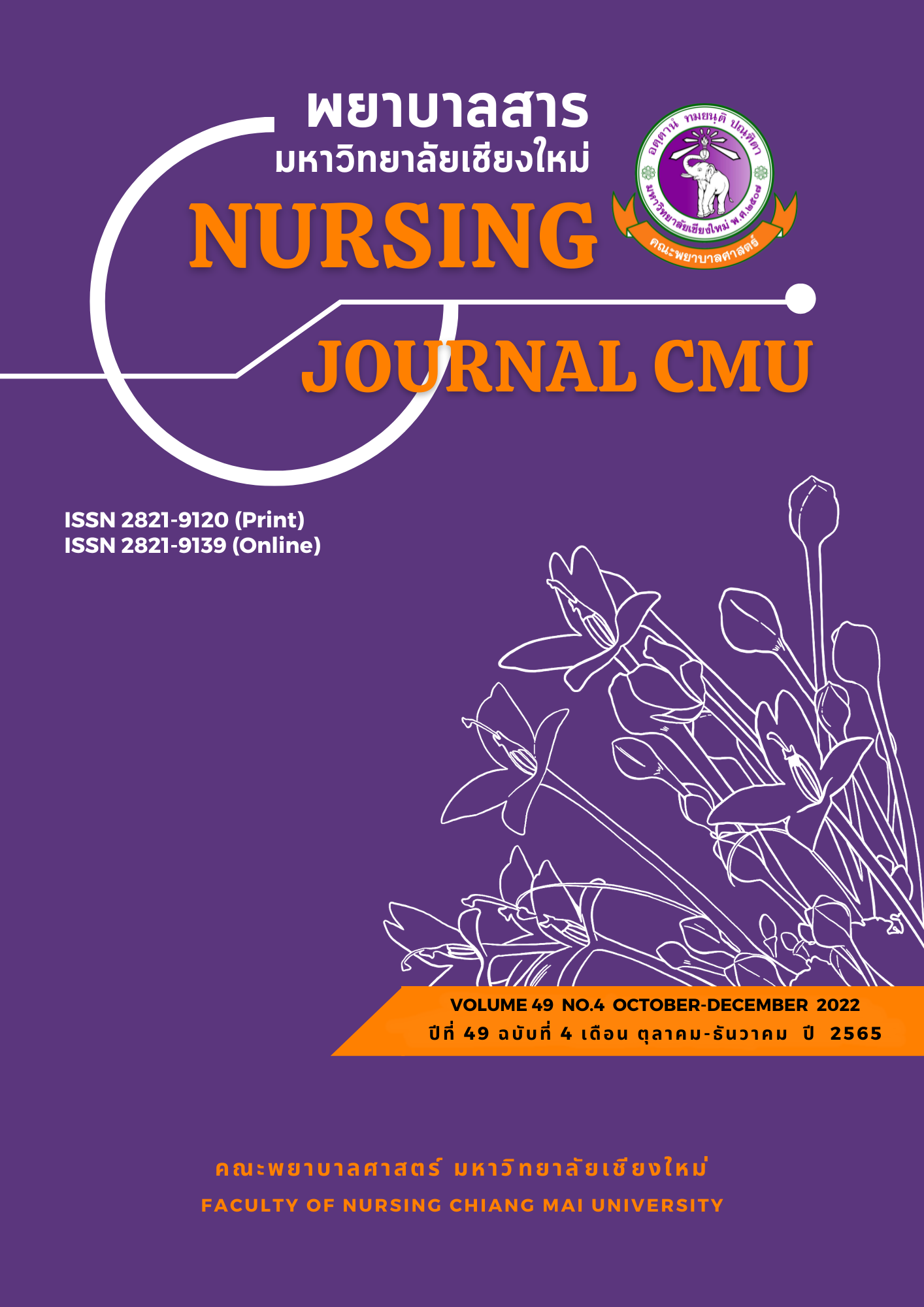Effects of a Self-efficacy Enhancing Program on Disease Control Behaviors, Interdialytic Weight Gain, and Predialysis Blood Pressure in Persons Receiving Hemodialysis
Keywords:
Enhancing self-efficacy program, Disease control behavior, Interdialytic weight gain, Predialysis blood pressure, Person receiving hemodialysisAbstract
Increased interdialytic weight gain (IDWG) is associated with increased predialysis blood pressure and mortality among hemodialytic patients. These conditions can be controlled by adopting regular healthy behavior. Promoting patients’ beliefs about their capabilities to perform at designated levels in controlling the conditions of their illness is very important. This quasi-experimental study aimed to examine the effects of a self-efficacy enhancing program on disease control behaviors, IDWG, and predialysis blood pressure among persons receiving hemodialysis. A purposive sample consisted of 36 hemodialysis patients receiving hemodialysis at Fort Kawila Hospital, Chiang Mai province. The participants were randomly assigned to be in either a control group (n = 18) or an experimental
(n = 18) group. The control group received usual care, while the experimental group received the self-efficacy enhancing program from the researcher along with usual care. The research instruments were composed of the self-efficacy enhancing program, developed by the researcher; the disease control behavior assessment; and the IDWG and predialysis blood pressure record form. Data were collected before entering the program and at the twelfth week after the completion of the program. Data were analyzed using descriptive statistics, repeated measure ANOVA, and paired t-test.
The results of the study revealed the following:
1. The hemodialysis persons who received the self-efficacy enhancing program with usual care had statistically significant higher disease control behavior than those who only received usual care(p < .001).
2. The hemodialysis persons who received the self-efficacy enhancing program with usual care had statistically significant lower IDWG than those who received usual care (p < .05).
3. The hemodialysis persons who received the self-efficacy enhancing program with usual care had no statistically significant different predialysis blood pressure from those who received usual care.
The results of this study confirmed the effectiveness of the self-empowerment program. It can be used in hemodialysis units to promote healthy behavior and control IDWG among persons receiving hemodialysis. Long term study is recommended to follow up on the sustainability of these results.
References
Aliasgharpour, M., Shomali, M., Moghaddam, M. Z., & Faghihzadeh, S. (2012). Effect of a self-efficacy promotion training programme on the body weight changes in patients undergoing haemodialysis. Journal of Renal Care, 38(3), 155-161.
Arammuang, S. (2011). Factors predicting fluid control behavior in chronic kidney disease patients receiving hemodialysis (Master’s thesis). Mahidol University, Thailand. (in Thai)
Bandura, A. (1997). Self-efficacy: The exercise of control. New York: W. H. Freeman.
Charra, B. (2007). Fluid balance, dry weight, and blood pressure in dialysis. Hemodialysis International, 11(1), 21-31.
Foote, E. F., & Manley, H. J. (2008). Hemodialysis and peritoneal dialysis. Retrieved from http://highered.mheducation.com/sites/dl/free/007147899x/603552/Pharmacotherapy_chap048.pdf
Himmelfarb, J. (2005). Hemodialysis complication. American Journal of Kidney Diseases, 45(6), 1122-1131.
Kalantar-Zadeh, K., Regidor, D. L., Kovesdy, C. P., Van Wyck, D., Bunnapradist, S., Horwich, T. B., & Fonarow, G. C. (2009). Fluid retention is associated with cardiovascular mortality in patients undergoing long-term hemodialysis. Circulation, 119(5), 671-679.
Khemkong, K. (2007). Health beliefs and food consumption behavior among patients with chronic renal failure at Sukhothai hospital (Unpublished master’s thesis). Chiang Mai University, Thailand. (in Thai)
Mathers, R. T. (2007). Nursing management: Acute renal failure and chronic kidney disease in S. L. Lewis, M. M. Heitkenper, S. R. Dirksen, P. G. O’Brien, & L. Bucher (Eds.), Medical-surgical nursing assessment and management of clinical problems (7th ed.). Philadelphia: Mosby Elsevier.
Molaison, E. F., & Yadrick, M. K. (2003). Stages of change and fluid intake in dialysis patients. Patient Education and Counseling, 24(5), 221-227.
National Institute of Diabetes and Digestive and Kidney Diseases [NIDDKD]. (2006). Treatment methods for kidney failure hemodialysis. Retrieved from http://www.niddk.nih.gov/health information/healthtopics/kidneydisease/hemodialysis/ Documents/hemodialysis_508.pdf
Nerbass, F. B., Morais, J. G., Santoe, R. G., Kruger, T. S., Koene, T. T., & Filho, H. A. L. (2011). Factors related to interdialytic weight gain in hemodialysis patients. Journal Brasileiro de Nefrologia, 33(3), 300-305.
Phunsai, Y. (2012) Clinical situational analysis of fluid overload management among chronic kidney disease patients receiving hemodialysis, Lampang hospital (Unpublished master’s thesis). Chiang Mai University, Thailand. (in Thai)
Puengchompoo, W., (2014). Situation of palliative care in Thai elderly patients with end stage renal disease. Nursing Journal, 41(4), 166-177. (in Thai)
Riamchan, S. (2011). Effects of the self-efficacy and social support enhancement program on disease control behaviors and serum creatinine level among the elderly with end stage renal disease receiving hemodialysis (Unpublished master’s thesis). Chiang Mai University, Thailand. (in Thai)
Singh, S., Shankar, R., & Singh, G. P. (2017). Prevalence and associated risk factors of hypertension: A cross-sectional study in Urban Varanasi. International Journal of Hypertension, 2017, 1-10. doi: 10.1155/2017/5491838
Social and Quality of Life Database System. (2017). Cause-specific death rate per 100,000 person-year in 1998-2016. Retrieved from http://social.nesdb.go.th/SocialStat/Stat Report_Final.aspx?reportid=441&template=2R1C&yeartype=M&subcatid=15
Strategy and Planning Division Office of the Permanent Secretary. (2016). Summary report of illness in 2016. Bangkok: The War Veterans Organization of Thailand.
Tsay, S. L. (2003). Self-efficacy training for patients with end-stage renal disease. Journal of Advanced Nursing, 43, 370-375.
Tzanakaki, E., Boudouri, V., Stavropoulou, A., Stylianou, K., Michael, R., & Zidianakis, Z. (2014). Causes and complications of chronic kidney disease in patients on dialysis. Health Science Journal, 8(3), 343-349.
Downloads
Published
How to Cite
Issue
Section
License
Copyright (c) 2022 Nursing Journal

This work is licensed under a Creative Commons Attribution-NonCommercial-NoDerivatives 4.0 International License.
บทความที่ได้รับการตีพิมพ์เป็นลิขสิทธิ์ของวารสารพยาบาลสาร
ข้อความที่ปรากฏในบทความแต่ละเรื่องในวารสารวิชาการเล่มนี้เป็นความคิดเห็นส่วนตัวของผู้เขียนแต่ละท่านไม่เกี่ยวข้องกับมหาวิทยาลัยเชียงใหม่ และคณาจารย์ท่านอื่นๆในมหาวิทยาลัยฯ แต่อย่างใด ความรับผิดชอบองค์ประกอบทั้งหมดของบทความแต่ละเรื่องเป็นของผู้เขียนแต่ละท่าน หากมีความผิดพลาดใด ๆ ผู้เขียนแต่ละท่านจะรับผิดชอบบทความของตนเองแต่ผู้เดียว






